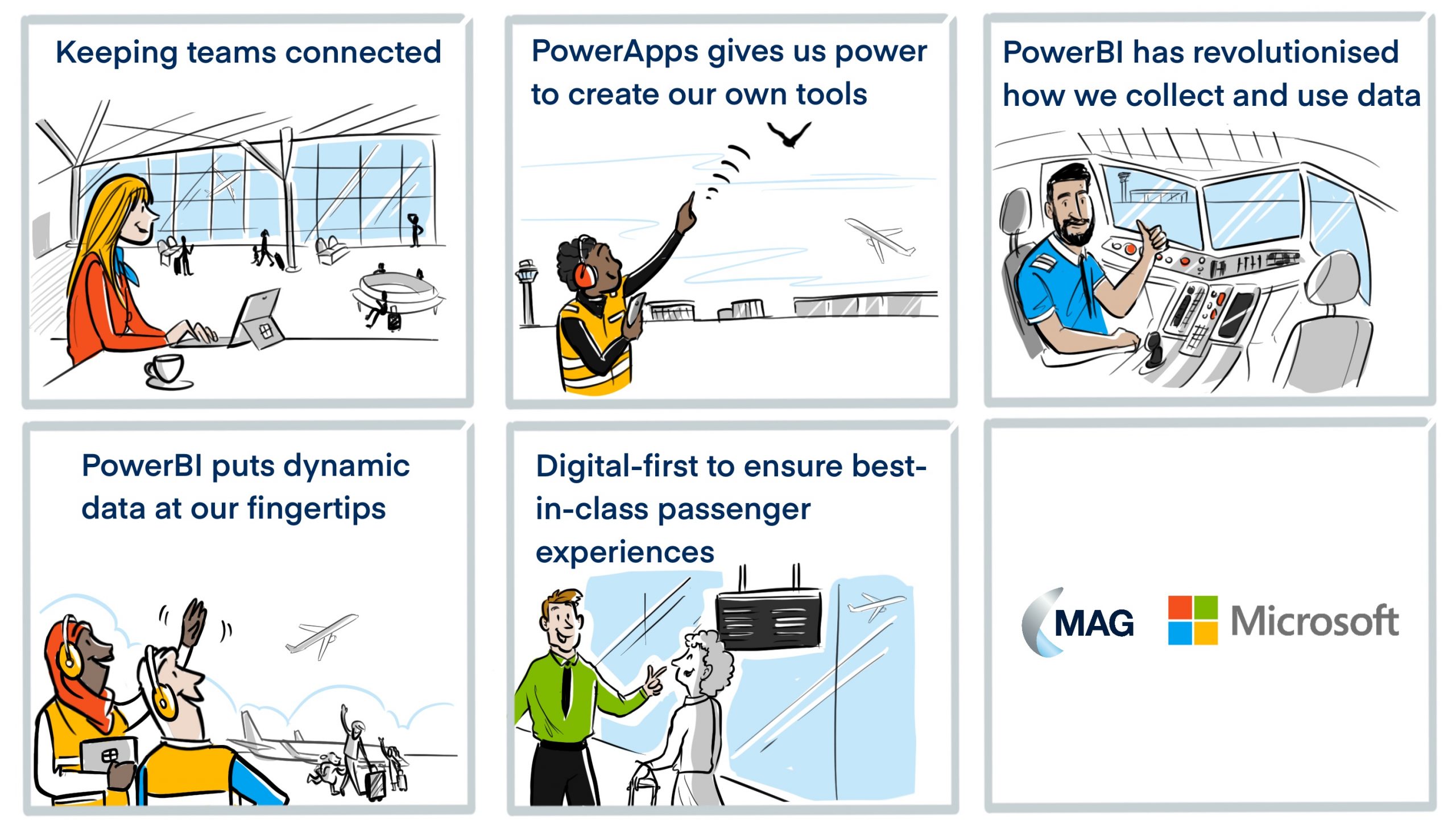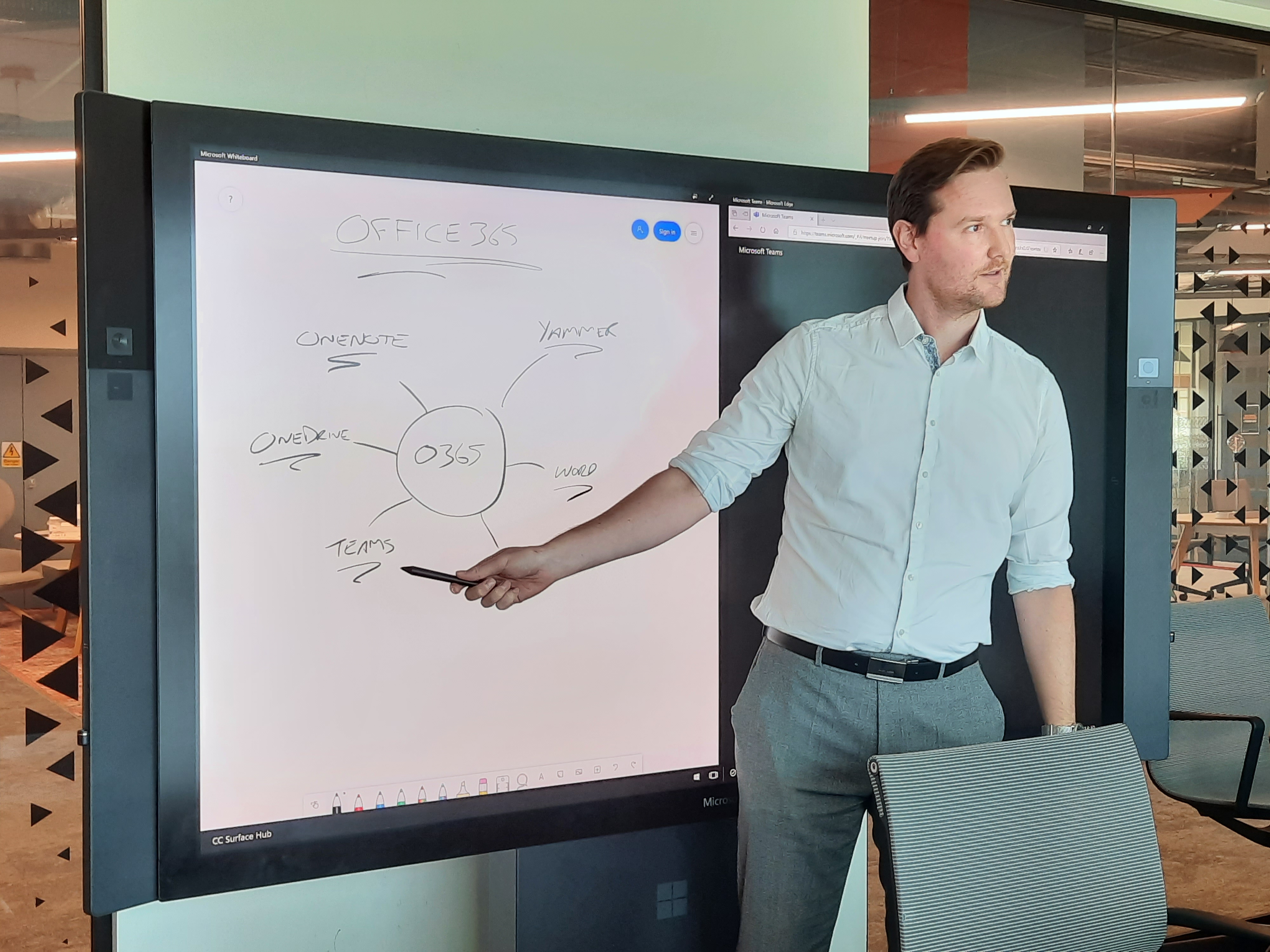
Tech is taking off at Manchester Airports Group
Airports are always busy. A regular stream of people move through huge terminals to jet off on holidays or business trips, while passports are checked and luggage is scanned and taken away on conveyer belts. Thousands of staff keeping things moving, from air-traffic controllers monitoring the skies to truck drivers transporting parcels and packages in and out of terminals.
Airports are small cities that never sleep.
Manchester, London Stansted and East Midlands Airports are three of the busiest transport hubs in the UK. There, the hum of activity never stops – 24 hours a day, seven days a week.
In March 2020, the COVID-19 pandemic hit and holidays and weekends abroad were replaced with working from home and “staycations”. Passenger numbers in April 2021 were 96.7% lower compared with the same month in 2019.
Manchester Airports Group (MAG), which runs those three airports, could have focused on the short-term problems that all travel companies were suddenly faced with. Instead, its leaders saw an opportunity to use this quieter time to step up their digital transformation with Microsoft, so when travellers could eventually return, they would be greeted by one of the best travel experiences anywhere in Europe.
“As the Covid crisis hit, airports and borders across the globe closed and it was clear the impact on our industry, would be incredibly hard-hitting,” said Karen Smart, Managing Director at Manchester Airport. “Despite this, MAG is a forward-thinking business and so, while adapting our business to survive the financial impact of the pandemic, we also used this time to accelerate our digital transformation.
“By embracing technology such as Microsoft’s, we’ve been able to utilise the past 12 to 18 months to pivot our ways of working, enabling us to enter the recovery from COVID-19 on the front foot, empowering our business to work faster and smarter.”
MAG is using Microsoft Azure, Surface devices, Microsoft 365 and Power Platform to connect its 40,000 staff, helping them communicate, innovate, collaborate and collect and share information seamlessly and in real-time.
It has created a flowing network of data that gives employees greater insight into what’s happening across the site, enabling them to make passenger journeys easier and more comfortable.

Every year, 60 million passengers fly through Manchester, London Stansted and East Midlands airports. East Midlands also handles more than 800,000 tonnes of air cargo (worth a total of £27.5 billion) on over 40,000 dedicated freighter flights; so MAG needed technology that was innovative, reliable and secure.
“We were already using Microsoft 365 when COVID-19 hit,” said Nicholas Woods, Chief Information Officer at MAG. “What the pandemic did was speed up adoption and as people used it more, they found it enabled them to do so many new and exciting things. It allowed them to work quicker and smarter. This experience created the appetite for more technology. A digital transformation that would have usually taken three years saw adoption and innovation in a matter of months.”
MAG quickly launched Microsoft Teams, OneDrive and OneNote training sessions, adapted for people’s level of confidence in using the technology. The sessions empowered staff to collaborate and communicate from any location, while “In Context” sessions helped entire departments use Microsoft 365 on specific projects. Using technology to enable hybrid working is something that’s top of mind for MAG.
Woods added: “The pandemic changed everything, including how our people work. Going forward, we will continue to support colleagues as they work in a way that suits them – that might be working from home, at an MAG site or a combination of the two. The key thing is that we now have the technology to be able to make those decisions work for our employees.”
Some roles are more adaptable to a hybrid way of working than others – for example, MAG owns and operates three out of the top four cargo airports in the UK, and moving items requires staff to be on site. However, where possible, MAG delivers a “best-in-class digital experience for employees, enabling a balanced, sustainable and resilient workplace of the future”.

Employees are now being given Surface Pro devices to bring them together virtually, allowing them to work as if they were in the same room. Teams is fast becoming the “prime platform for making and receiving calls”, while the Whiteboard and Sketch features – allowing digital notes, signatures and drawings in on-screen documents using the Surface Pen – mean staff are using less paper.
It’s a transformation that Nick Hedderman, Director or Microsoft’s Modern Work and Security Business Group, has seen at many companies across multiple sectors.
“We are entering a new world of hybrid working, which will require businesses to be purposeful about re-designing their work practices and policies, inclusive of how digital technology plays a supporting role” he said. “MAG is an incredible example of an organisation that is embracing a hybrid approach, with their staff and customers seeing the benefits of that decision.”
The power of data
MAG is a large operation: Manchester Airport is the third busiest airport in Britain and one of only two airports in the country with two runways, London Stansted provides London with more visitors from Europe than any other airport, and East Midlands Airport welcomes more than 4.8 million passengers every year as well as being a specialist in handling the world’s largest cargo aircraft (including the AN-225 and B747-8F) and “outsize” cargo.
Airports are tightly managed to ensure efficiency and security, with teams relying on data to ensure everything runs smoothly. Everything from passenger numbers in the terminals, flight data and customer satisfaction scores, to security and wildlife on the airfield, is recorded and analysed.

The amount of data MAG had to handle wasn’t going to decline – if anything, it was going to increase due to its digital transformation – but the time spent by staff collecting and preparing that information could be significantly reduced. They started using Power BI and Power Apps.
“Before we began working with Power BI, the analysis conducted to bring together our passenger metrics involved a considerable amount of manual work running various spreadsheets, cleaning raw data daily and creating PowerPoint packs on a weekly basis,” Dave Scally, Performance and Insight Senior Analyst at MAG, said.

“Power BI has revolutionised how we complete our customer analytics. By feeding our raw data sources into it, with just a touch of a button, our analytics are complete. We now have all our passenger metrics in one place. This enables us to clearly see, in moments, how each element of the passenger journey is performing and drill down into the data with ease and speed.
“Power BI has not just improved our analytical processes but has also transformed the experience for our end users. Now, each business area can easily see how their department area impacts the Voice of the Customer [MAG’s combined customer data] by being able to self-serve their own data on visually stimulating reports, including the ability to read word-for-word what our passengers have said about their experience with us.
“The improvements that Power BI has delivered to us are vast. Through this technology we are able work smarter, save significant resource time in delivering insight and action, with data that is accurate.”
By automating the transformation of data, MAG has replaced paper forms, resolved issues faster, provided data quicker and enabled more informed decision making.
Passenger and flight data used to sit in a third-party software system, which offered no way to visually display the information. By using Power Automate, daily traffic statistics, insight into where passengers are flying to, load factors and popular destinations are now automatically uploaded to a Sharepoint folder. A Power BI dashboard then ingests that data and updates the visual dashboard in an easy-to-read format for members of staff.

To further enhance the insights, flight data from the past 10 years has been ingested into the Power BI dashboard, allowing for trend analysis of routes and airlines. This automated display of flight data had never been available at MAG before.
Marie Abery, Dynamics Business Group Director at Microsoft, said data automation will play an increasingly important role for businesses.
“Automated data solutions like the ones MAG is rolling out will be the norm for businesses who want to spend less time collecting information and more time using it to improve how they work,” she said. “Microsoft technology is empowering staff by giving them data where they want, when they want, in easy-to-read formats. The Power Platform is truly putting data at the heart of business decision-making.”
Not only is data is improving operations at MAG, it’s also making its airports safer.
According to the latest Civil Aviation Authority figures, there were almost 3,500 instances of birds striking planes in 2017, indicating a steady increase since 2013. While just 4.5% of those incidents resulted in damage to the aircraft, the plane must be grounded and successfully complete a range tests after a bird strike incident to ensure it can safely return to the skies. That can cause issues for the airport, which may have to divert resources to help passengers continue their journeys on other flights.
MAG built a Power App that is used on tablet devices by its Airfield Operations Team. Using GPS, the app tracks the exact location of wildlife sightings. Staff can take photographs of the wildlife using the app’s photo tool to help identify species or provide more information on their location. Weather information is also fed into the system from an external web-based weather API to add extra information on to the report.

“By using PowerApps, we have given the Airfield Operations Team far more precise data on the recording of wildlife than we’ve had before,” Woods said. “A Power BI dashboard shows staff a map of the airfield with each sighting plotted onto it. Users can then hover their cursor over each sighting to get all the information they need. This helps staff understand possible patterns of wildlife so preventative action can be taken in advance, making the airfield much safer for the operation of aircraft.”
Apps, collaboration, communication, security, data – that’s a lot of digital transformation in just a year. But MAG is looking to go further. It will soon open a state-of-the-art terminal with enhanced technology in Manchester, just as passengers are returning to airports for international travel. The timing is perfect.
“We are ready to ‘to get back to travel’ and see what more we can achieve with the power of Microsoft technology in our hands,” Woods said.
To learn more check out the full customer story.

